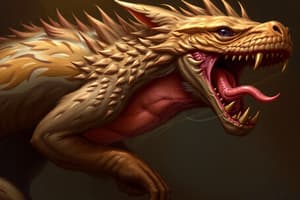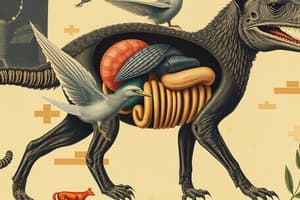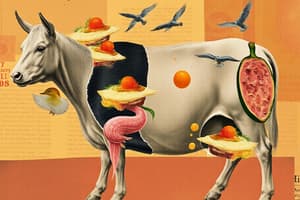Podcast
Questions and Answers
Which aspect of diversity in life is often underestimated?
Which aspect of diversity in life is often underestimated?
- Evolutionary convergence among unrelated species (correct)
- Genetic variation within species
- Distribution of species in various habitats
- Morphological similarities across different taxa
Which factor does NOT significantly influence the history of life on Earth?
Which factor does NOT significantly influence the history of life on Earth?
- Climate changes over geological time
- Plate tectonics and continental drift
- Asteroid impacts
- Human activities in the last century (correct)
What role do fossil records play in understanding the diversity of life?
What role do fossil records play in understanding the diversity of life?
- They provide a complete account of all species that ever existed.
- They only show the geographical distribution of living species.
- They help trace evolutionary lineages and extinct species. (correct)
- They are primarily used for dating geological layers.
Which concept is key to the study of evolutionary biology in the context of life diversity?
Which concept is key to the study of evolutionary biology in the context of life diversity?
Which of the following is NOT a mechanism of evolutionary change?
Which of the following is NOT a mechanism of evolutionary change?
Which of the following is NOT a characteristic present in all animals, according to the lecture outline?
Which of the following is NOT a characteristic present in all animals, according to the lecture outline?
What is referred to as an elastic structure found in certain animals?
What is referred to as an elastic structure found in certain animals?
Which feeding strategy is NOT classified under ecological roles in animals?
Which feeding strategy is NOT classified under ecological roles in animals?
What is metamorphosis primarily characterized by?
What is metamorphosis primarily characterized by?
Which animal group is known to lack nervous tissue?
Which animal group is known to lack nervous tissue?
What role do decomposers primarily play in an ecosystem?
What role do decomposers primarily play in an ecosystem?
What is an adaptive benefit of metamorphosis in animals?
What is an adaptive benefit of metamorphosis in animals?
What does the term 'synapomorphy' refer to in the context of animal lineage?
What does the term 'synapomorphy' refer to in the context of animal lineage?
What type of animals have two tissue layers?
What type of animals have two tissue layers?
Which of the following statements accurately describes gastrulation?
Which of the following statements accurately describes gastrulation?
What is the main characteristic of triploblasts?
What is the main characteristic of triploblasts?
What defines cephalization in later animals?
What defines cephalization in later animals?
What type of body cavity do coelomates have?
What type of body cavity do coelomates have?
Which animals lack body cavities?
Which animals lack body cavities?
What is a specialized region of the digestive tract called?
What is a specialized region of the digestive tract called?
Which type of symmetry is often associated with more complex animal structures?
Which type of symmetry is often associated with more complex animal structures?
What is a key characteristic of HOX genes?
What is a key characteristic of HOX genes?
What happens when there is a mutation in a HOX gene?
What happens when there is a mutation in a HOX gene?
What does the concept of deep/genetic homology refer to?
What does the concept of deep/genetic homology refer to?
Which type of genes do sponges possess that has significance for deep homology?
Which type of genes do sponges possess that has significance for deep homology?
Which statement best describes HOX genes across different animal groups?
Which statement best describes HOX genes across different animal groups?
What type of structures may jellyfish possess genes to produce?
What type of structures may jellyfish possess genes to produce?
What is a fundamental feature of developmental regulatory genes?
What is a fundamental feature of developmental regulatory genes?
What is a common outcome when similar structures evolve independently in different organisms?
What is a common outcome when similar structures evolve independently in different organisms?
Flashcards
Skeletal Outline
Skeletal Outline
A structured summary of a lecture or textbook, highlighting key topics and concepts.
Lecture
Lecture
A formal presentation of information given by an instructor to a class.
BIO 150
BIO 150
A specific course focusing on the diversity and history of life.
Key Topics
Key Topics
Signup and view all the flashcards
Concepts
Concepts
Signup and view all the flashcards
Body Symmetry
Body Symmetry
Signup and view all the flashcards
Radial Symmetry
Radial Symmetry
Signup and view all the flashcards
Bilateral Symmetry
Bilateral Symmetry
Signup and view all the flashcards
Diploblastic Animals
Diploblastic Animals
Signup and view all the flashcards
Triploblastic Animals
Triploblastic Animals
Signup and view all the flashcards
Gastrulation
Gastrulation
Signup and view all the flashcards
Coelom
Coelom
Signup and view all the flashcards
Cephalization
Cephalization
Signup and view all the flashcards
Animal Characteristics
Animal Characteristics
Signup and view all the flashcards
Eukaryotic cells
Eukaryotic cells
Signup and view all the flashcards
What is a cell membrane?
What is a cell membrane?
Signup and view all the flashcards
Heterotrophic
Heterotrophic
Signup and view all the flashcards
Internal Environment
Internal Environment
Signup and view all the flashcards
Motility
Motility
Signup and view all the flashcards
What are the purposes of movement?
What are the purposes of movement?
Signup and view all the flashcards
Metamorphosis
Metamorphosis
Signup and view all the flashcards
Developmental Regulatory Genes
Developmental Regulatory Genes
Signup and view all the flashcards
HOX Genes
HOX Genes
Signup and view all the flashcards
Highly Conserved
Highly Conserved
Signup and view all the flashcards
Mutation in HOX Gene
Mutation in HOX Gene
Signup and view all the flashcards
Deep Homology
Deep Homology
Signup and view all the flashcards
Genes used to produce these structures
Genes used to produce these structures
Signup and view all the flashcards
Sponges have genes that make ______________________________
Sponges have genes that make ______________________________
Signup and view all the flashcards
Jellyfish have genes that could make them _______________________________
Jellyfish have genes that could make them _______________________________
Signup and view all the flashcards
What characteristics define animals?
What characteristics define animals?
Signup and view all the flashcards
What are the major gut types?
What are the major gut types?
Signup and view all the flashcards
What is a coelom?
What is a coelom?
Signup and view all the flashcards
What are the major causes of animal diversification?
What are the major causes of animal diversification?
Signup and view all the flashcards
What are HOX genes & what do they do?
What are HOX genes & what do they do?
Signup and view all the flashcards
Study Notes
Animal Characteristics
- Animals are multicellular organisms
- Animal bodies are made of collagen, an elastic connective tissue
- Collagen is one of the most common proteins in animals
Feeding Strategies & Ecological Roles
- Suspension Feeders: Filter particles floating in water or drifting through air.
- Fluid Feeders: Consume liquids such as plant sap, nectar, or juices from organic matter.
- Deposit Feeders: Ingest organic matter that has been deposited.
- Mass Feeders: Consume large chunks of food, such as dead organic matter or other animals.
- Herbivores: Consume plants and algae.
- Carnivores: Consume animals.
- Omnivores: Consume both plants and animals.
- Detritivores: Consume dead organic matter.
Movement
- Animals move to find food, mates, escape predators, and disperse to new areas
- All animals except sponges have muscle tissue to facilitate movement
Life Cycle
- Most animals are diploid and reproduce with haploid gametes
Metamorphosis
- Metamorphosis is a massive morphological change between juvenile and adult life stages
- Adaptive benefits include avoiding competition between juveniles and adults, and allowing for slow movement in species that are sessile as juveniles
Body Symmetry
- Asymmetry: No planes of symmetry
- Radial Symmetry: Multiple planes of symmetry
- Bilateral Symmetry: Two planes of symmetry
- Pentaradical Symmetry: Five planes of symmetry
Tissue Layers
- Diploblasts: Have two tissue layers (ectoderm and endoderm)
- Triploblasts: Have three tissue layers (ectoderm, mesoderm, and endoderm)
Gut Types
- Incomplete Gut: One opening for ingestion and egestion
- Complete Gut: Two openings, mouth and anus, for ingestion and egestion
Tissue Differentiation
- Gastrulation: Formation of the gastrula, involving the invagination of the blastula and placement of cells within a gastrula.
- Gastrulation determines tissue fate.
Cell Types in Adult
- Ectoderm: Outer layer, forms outer surface epidermal cells.
- Mesoderm: Middle layer, forms tissues like muscles and bone.
- Endoderm: Inner layer, forms the lining of the digestive tube.
Gut Type or Organization of Digestive Tract
- Includes different gut types, number of openings, food direction, and specialized regions.
- Differences in gut structures enable the body's internal organs to function independently.
Animal Diversification
- High oxygen levels at the start of the Cambrian explosion were crucial for animal development.
- Aerobic respiration allowed for metabolically more active and larger animals.
- More abundant food led to more varied feeding strategies.
- Predation pressures led to the development of protective structures and behaviors
Evolution of Genetic Toolkit
- Various sets of developmental regulatory genes allow for large changes in body organization without changes to their genome
- HOX genes are highly conserved across species and control the arrangement of body parts.
- HOX genes are crucial for development and dictate the body plan
Studying That Suits You
Use AI to generate personalized quizzes and flashcards to suit your learning preferences.




